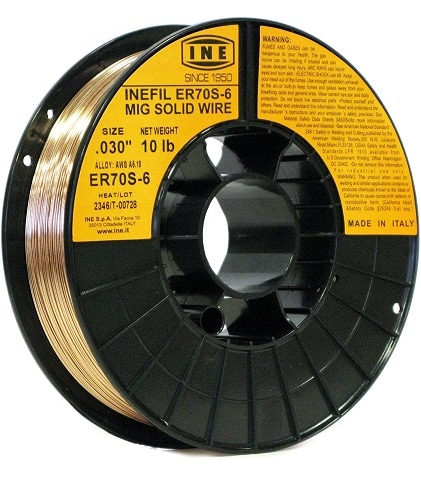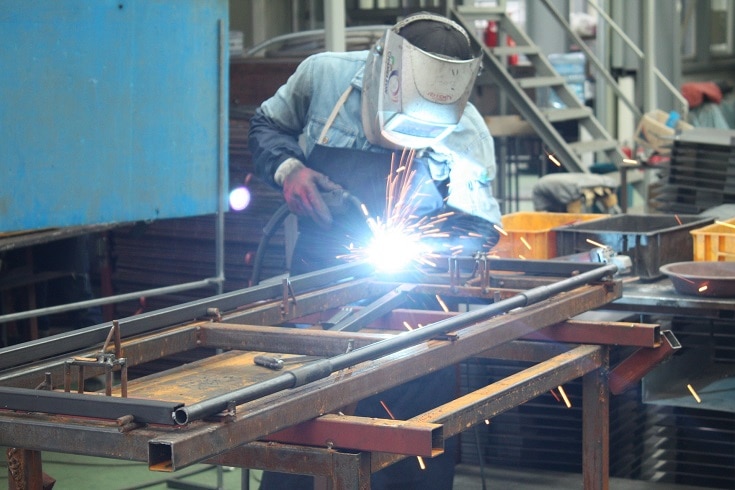What is Welding Wire, and What Types Are There? 2024 Guide
Last Updated on

All arc welding processes utilize electricity to create an extremely hot arc that melts the base metal of the joint members. This creates fusion. This fusion is aided by another molten metal, that is the filler metal. All arc welding processes utilize filler metal. With Stick welding (SMAW), it is the coated electrode. TIG welding uses filler rods that are dipped into the weld pool. However, MIG and FCAW welding processes use welding wire.
What is Welding Wire?
Welding wire is the electrode in the welding process. This means that the electrical arc spans the gap between the surface of the workpiece and the end of the wire. It is what helps initiate the arc. In addition to functioning as the electrode side of the arc, it is itself also the filler metal that enters the molten weld pool to form the strong bond.
How Does It Work?
Welding wire is deposited using a wire feed system. Wrapped on individual spools, it is placed on the wire feeder of a welding machine. Each time the trigger is pulled on the welding gun, the wire feeds and when it makes contact with the electrically grounded workpiece surface, the arc initiates, beginning the process of melting the base metal. Then the wire melts from the heat of the arc and the filler metal is deposited into the weld pool.
What Types of Welding Wire are there?
Welding wire is not limited to one kind of filler metal. Aluminum, stainless steel, mild steel, galvanized steel, and alloyed materials can all be welded using welding wire of various diameters, provided that a suitable wire exists for that type of base metal. But generally speaking, there are two categories of welding wire.
Hard Wire
This is used with MIG welding, which oftentimes is just called ‘hard wire.’ It gets its name from the fact that it can only be clipped with welding pliers whereas flux-cored wire can be broken by hand. Hardwire must be used with shielding gas in order to protect the weld during the liquid state.

Flux-Cored Wire
Flux-cored wire is a tubular filler metal with a flux in the center of the wire. This family of wire includes dual shield, which utilizes the protection from the flux as well as a shielding gas, and self-shielded which relies solely upon the flux.
What is Welding Wire Made of?
Hard Wire
MIG welding wire is primarily made of base metal. It may also include manganese, titanium, and silicon (residue of which can often be seen after welding). The wire is typically coated in copper which in addition to helping reduce oxidization during welding, can prevent the wire from rusting too.
Flux-Cored Wire
The filler metal choice for this is most often mild steel. But it can include other things as well. Nickel is a common alloy for this type of wire. In addition to the filler metal, it includes a mix of deoxidizers, fluxes, metal powders, and other alloys.
Frequently Asked Questions (FAQs)
Does Flux-Cored Wire Go Bad?
Yes, FCAW wire can expire. It will expire quicker if it is exposed to harsh conditions. Be sure to keep your wire dry and away from any moisture.

What Welding Wire Works without Gas?
Welding wires designed for FCAW-S, which is Self-Shielded flux-cored welding, do not require shielding gas.
Is Flux-Cored the Same Thing as MIG Welding?
Let’s put it this way. Flux-cored welding is a type of MIG welding. It uses the same equipment, has the same type of current, etc. The difference lies in the fact that one wire uses flux and the other is a solid wire.
Final Thoughts
There are plenty of options for you to choose from if you need to select a welding wire. Depending on the size of the weld that you need to make, you will need to change the diameter of your wire. Some common sizes include .035 of an inch, .045, .052, and 1/16th. Some horizontal and flat position FCAW ‘hog wire’ is 1/8-inch. This is quite the range that gives the welder plenty of options.
